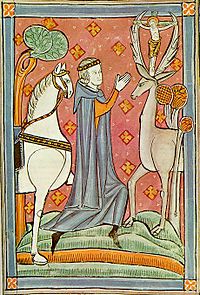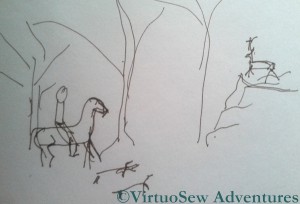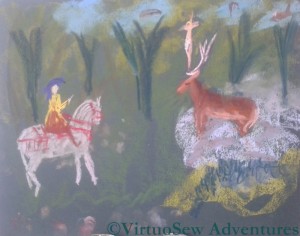Some opportunistic research for the Vision of Placidus

Conversion of St Hubert (Image from Wikipedia)
Shortly after I had my idea for a panel depicting the Vision of Placidus, I went to London for a lecture. The Pisanello is in The National Gallery, so after the lecture I took the opportunity, before catching the train home, to go to see the painting in real life. It turns out that St Hubert had a similar Conversion experience, so as well as the Pisanello “Vision of St Eustace” I found a fragment of an altarpiece entitled “The Conversion of St Hubert”…
I eventually tracked down the Pisanello, in the Sainsbury wing, and found it very much smaller than I expected – about A2 in size – which is much smaller than I am planning (about five foot by three foot). It was also just as dark as the reproduction I showed you in the first post about this idea. I sat down on a convenient window seat nearby, and started taking notes of the further research I need to do.
I will need picture references for
- a horse reined in from a gallop
- a stag with huge antlers
- hounds alert but not moving
- forest flora and fauna
- crucifix
- rocky outcrop
- suitably rich and exotic clothing for the huntsman
I also want to differentiate the vegetation from the background rather more, pull the rocky outcrop away from the background a bit more, and make the crucifix seem to grow out of the antlers rather more than it does in Pisanello’s painting.
While I was there, I sketched a very approximate idea of the space I want in the picture – the Pisanallo and the altarpiece, and the picture above, are all quite compressed and condensed, and at the moment my idea is to have much more space and “air” in the design.
When I got home I had another go, this time in pastels. Some elements of the pastel work quite well – the horse and its harness, and the crucifix between the deer’s antlers. Others are not so good – the trees in the background are too regularly spaced and too similar in shape, and, like the Pisanello, there isn’t as much space between the stag and the horse as I would like.
I need to be careful, here. If I concentrate too much on creating painted sketches, I might drive out all the stitching ideas, but at the same time, the more I think about the design, the better the chance I have of producing a panel I am happy with!



This looks a very interesting project, will look forward to watching it grow. The Royal Armouries in Leeds has a very good library worth a visit. I worked there for a time and spent a lot of time in the library researching costume amongst other things. They’d have images of hunting scenes which I’m sure would be very helpful. Not sure who is in charge now but I’m sure they’d be very happy to help. In fact one of my projects that is ‘in a holding pattern’ is based on an armour in the tournament gallery – need to do more research myself.
What an ambitious project and I’ll be here awaiting each and every bit of it. Your research, drawings and pastel are very intriguing.
It is good to see the stages that you are going through for this major project – recently I have been playing with projects that fit on a sheet of A4!
What a fascinating project. Love the tapestry of the conversion… and wonder why a deer is involved…
I will be fascinated to see how you progress with this project, it sounds a mammoth undertaking!
Yes, I know what you mean about the danger of it becoming ‘painting in stitch’ rather than the stitch-driven pieces that you prefer. But you can always come back to careful thought about the stitches once you have the design elements of the piece sorted, and clarity about the feel of it. And of course the longer you spend now letting all that gently fall in to place, the better the experience of stitching it will be when you do eventually get around to it.
the artwork is already informing the future embroidery and I don’t think you will lose sight of the importance of retaining the initial desire regarding embroidery
It’s really interesting to see the stages and levels of preparation for this and how already you’re identifying elements you want and don’t want which saves an awful lot of problems when you start to stitch. Fascinating!
This is a really interesting piece. Your painting looks like a modern interpretation of this theme. Are you thinking of stitching it this way or using a more Medieval approach?